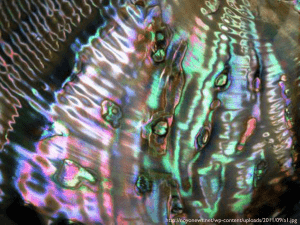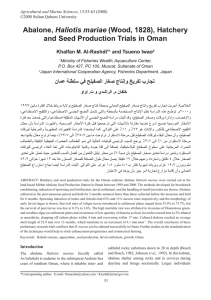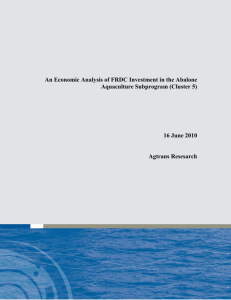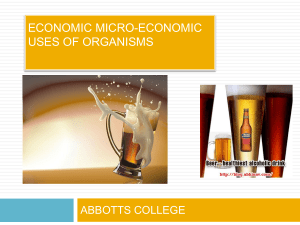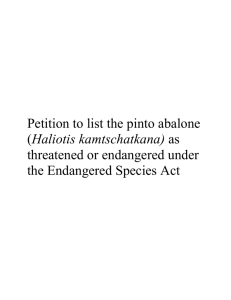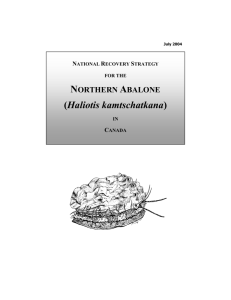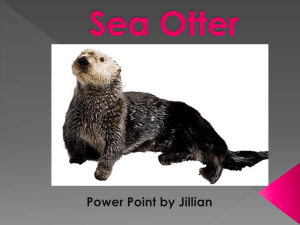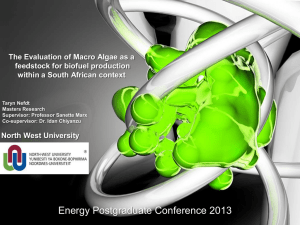Abalone - Dauphin Island Sea Lab
advertisement
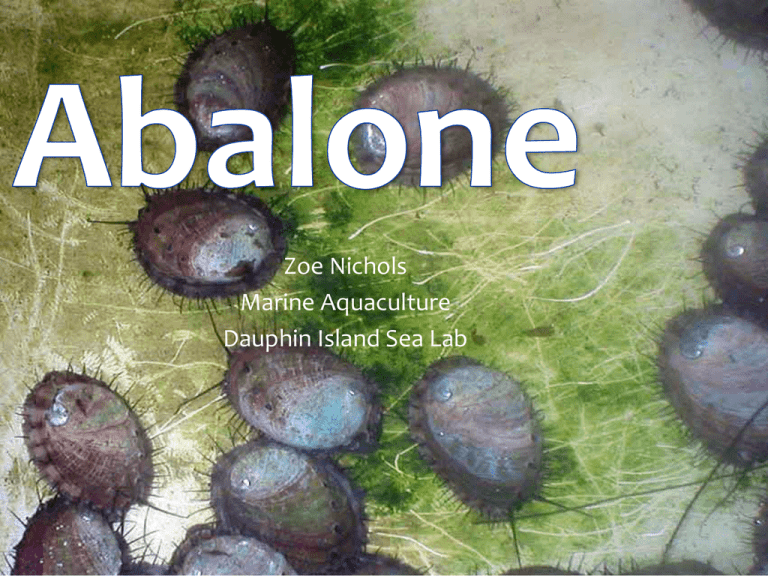
Zoe Nichols Marine Aquaculture Dauphin Island Sea Lab Taxonomy ● Kingdom: Animalia ● Phylum: Mollusca ● Class: Gastropoda ● Family: Haliotidae ● Genus: Haliotis ● Species:… Species ● There are about 100 species (150 with hybrids) ● Large abalones → temperate zone, small abalone → tropics and the cold zones. ● Haliotis asinina “Ass's Ear Abalone” South East Asia ● Haliotis rufescens “Red Abalone” California ● Haliotis discus “Disk Abalone” Japan ● Haliotis discus hannai “Japanese Abalone” Japan, Korea ● Haliotis diversicolor supertexta “Variouslly Coloured Abalone” Japan ● Haliotis fulgens “Green Abalone” Southern California ● Haliotis iris “Blackfoot Paua” New Zealand ● Haliotis kamtschatkana “Northern Abalone” California (endangered) ● Haliotis laevigata “Smooth Australian Abalone” Australia ● Haliotis midae “South African Abalone” South Africa ● Haliotis rubra “Blacklip Abalone”Australia ● Haliotis tuberculata “Green Ormer” Europe Species ● There are about 100 species (150 with hybrids) ● Large abalones → temperate zone, small abalone → tropics and the cold zones. ● Haliotis asinina “Ass's Ear Abalone” South East Asia ● Haliotis rufescens “Red Abalone” California ● Haliotis discus “Disk Abalone” Japan ● Haliotis discus hannai “Japanese Abalone” Japan, Korea ● Haliotis diversicolor supertexta “Variouslly Coloured Abalone” Japan ● Haliotis fulgens “Green Abalone” Southern California ● Haliotis iris “Blackfoot Paua” New Zealand ● Haliotis kamtschatkana “Northern Abalone” California (endangered) ● Haliotis laevigata “Smooth Australian Abalone” Australia ● Haliotis midae “South African Abalone” South Africa ● Haliotis rubra “Blacklip Abalone”Australia ● Haliotis tuberculata “Green Ormer” Europe Why Aquaculture Abalone? ● ● ● ● ● In the last 20+ years abalone populations have declined – Commercial catch worldwide has declined from 18,000mt to a little over 10,000mt – (predation, loss of habitat, illegal harvesting) An entree of two 4-inch abalone steaks can cost $50-plus Purchased raw, smaller abalone (in-shell) costs $20 per pound; the price increases as the abalone size increases. Market locations: Korea, Japan, Mexico, South Africa, Southern Australia, New Zealand, United States of America, and China Shells are part of the jewelry industry cause they’re pretty Abalone Life Cycle Reproduction In Captivity... ● Spawning occurs mostly during the summer months and multiple events during one season are possible 1.Ultraviolet method 2. Desiccation method 3. Thermal shock method ● The eggs & sperm are released → fertilization – ● ● A 1.5 inch abalone may spawn 10,000 eggs or more at a time, while an 8 inch abalone may spawn 11 million or more. 24hrs later egg hatches (microscopic) → free living larvae A week later, it settles on the bottom = spat – Begins to develop into an adult Production methods used: ● Juveniles are in controlled tanks and attached to setting boards ● When the juveniles reach 5–6 mm after 80 days → intermediate rearing tanks ● Intermediate culture period the abalones are reared up to 3 cm – ● (high density 3–5 kg/m2 and usually with a high survival rate) > 3cm Land-based rearing tanks or in the sea Production methods used: ● ● ● Land-based rearing tanks or in the sea The land-based method = easier management (artificial feed , electrical pumps, blowers) – Raised in concrete tanks with fresh sea water pumped in – Waste should be regularly removed- once a week at high temperatures, and once a fortnight at low temperatures IMTA- Israel – ● cultured marine fish, seaweeds, and Japanese abalone. The sea-based method uses rearing cage hung from a floating line or raft set at sea. – Affected by seasonal limitation of the environment/ density 2–3 kg/m2 – Dead organisms beneath the rearing tank should be removed and a good water flow provided Feeds and Feeding ● The diatom plates → feed free-swimming stage after spawning – ● Abalone eat marine algae in the wild and on some farms – ● Larvae will settle on the plates and feed on the diatoms Abalone farming limited by the quality and quantity of the macroalgae sources worldwide Cultured abalone, many farms now use high quality manufactured food, which is healthy, efficient and produces very high quality meat. ● Juvenile abalone usually feed on benthic diatoms and small benthic organisms. ● At 13 mm long they feed on a great variety of seaweeds – Large brown algae such as giant kelp, bull kelp, feather boa kelp and elk kelp ● Young barnacles, bivalves and foraminiferans are also found in the stomach of abalones ● Feeding habits affected by temperature (20 °C is optimum) How big can they get? How to have happy abalone... ● Water temperature 20°C ● Salinity >30 ‰ ● Do >4 ppm ● Light intensity >3000 Lux ● NH4OH-N <5 ppb ● PH 8.0–8.3 Advantages ● ● ● ● Leave little or no negative environmental effects Disadvantages ● Predators/ parasites if using cages in ocean ● 5-8 years to reach maturity ● A lot of natural food required- limiting ● Transfer of disease Low maintenance Can use high quality dried food Can use ocean water ● ● Sell meat and shells (60% weight) ● Live around 50 years Unwanted species trans located with abalones

